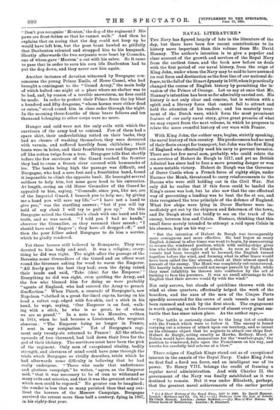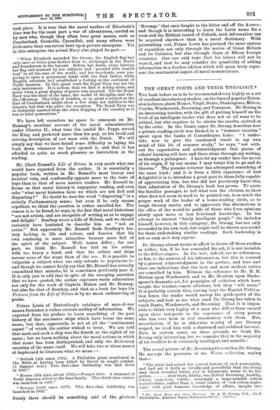NAVAL LITERATURE.* THE Navy has figured largely of late in
the literature of the day, but there have been few recent contributions to its history more important than this volume from Mr. David Hannay. The author's intention is to give a popular and clear account of the growth and services of the Royal Navy from the earliest times, and the book now before us deals with the first period of our naval history, from the reign of King John, under whom the Navy may be said to have assumed its real form and destination as the first line of our national de- fence, to the fall of the Stuart dynasty in 1688,when it practically changed the course of English history by permitting the in- vasion of the Prince of Orange. Let us say at once that Mr. Hannay's intention has been so far admirably carried out. His history is not only clear and concise, but is written with a spirit and a literary force that cannot fail to attract and hold the attention of his readers ; and his masterly treat- ment of the Dutch wars, which form the most prominent feature of our early naval story, gives great promise of what we may expect from the next volume, in which he proposes to relate the more eventful history of our wars with France.
With King John, the author says, begins, strictly speaking, the naval history of this country. His predecessors had no need of their fleets except for transport, but John was the first King of England who effectually used his navy to prevent invasion. There are but few naval men, probably, who could relate the sea services of Hubert de Burgh in 1217, and yet no British Admiral has since had to face a more pressing danger or won a more notable victory. Hubert de Burgh was the Governor of Dover Castle when a French force of eighty ships, under Eustace the Monk, threatened to carry reinforcements to the Barons who were still holding out in the Civil War. Not only did he realise that if this force could be landed the King's cause was lost, but he also saw that the one effectual way of preventing a landing was to beat the foe at sea, and thus recognised the true principle of the defence of England. What few ships were lying in Dover Harbour were im- mediately got out by the shipmen and fishermen of the town, and De Burgh stood out boldly to sea on the track of the enemy, between him and Calais. Eustace, thinking that this small force merely intended to attempt a raid upon Calais in his absence, kept on his way :- " But the intention of Hubert de Burgh was incomparably more courageous and more effective. He had begun as every English Admiral in after times was wont to begin, by manoeuvring to secure the windward position, which with sailing-ships gives him who holds it the option of attack. As soon as the French vessels had been brought well to leeward, the English turned together before the wind, and forming what in after times would have been called the line abreast, stood at their utmost speed in pursuit of the enemy. The Monk was completely out-manoeuvred. His heavily laden vessels could not escape pursuit by flight, while they must infallibly be thrown into confusion by the net of turning to face the pursuers. It was no small advantage to the English that their arrows would fly with the wind."
Not only arrows, but clouds of quicklime thrown with the wind at close quarters, effectually helped the work of the boarders, and the axes of the men of the Cinque Ports speedily accounted for the crews of such vessels as had not been rammed and sunk by the first shock. The engagement is worth quoting, as the forerunner of almost every great sea- battle that has since taken place. As the author says,- " The battle is curiously similar to the long list of conflicts with the French which were to follow it. The enemy is found carrying out a scheme of attack upon our territory, and so intent on his ultimate object that he neglects to attack our ships first. Hubert de Burgh, acting exactly as Hawke, Rodney, Hood, or Nelson would have done, manoeuvres for the ' weather-gage,' the position to windward, falls upon the Frenchman on his way, and wrecks his carefully laid scheme at a blow."
Three reigns of English Kings stand out as of exceptional interest in the annals of the Royal Navy. Under King John we first find a fixed sea force, and an intelligent use of its power. To Henry VIII. belongs the credit of framing a regular naval administration. And with Charles II. the government of the Navy was finally established as it was destined to remain. But it was under Elizabeth, perhaps, that the greatest naval achievements of the earlier period • (L) A. Short History of the Royal Nave, 1917 to 1688. By David Hannay. London : Methuen and Co. (73. 6d.]—(24 Pictures from the Life of Nelson. By Clark Russell. London James Bowden.—(3.) Hon-of.War Names. By Prince Louis of Battenberg. London : E. Stanford.
took place. It is true that the naval warfare of Elizabeth's time was for the most part a war of adventurers, carried on by men who, though they often bore great names, such as Cumberland, Grenville, Cavendish, and many others, were little more than sea-rovers bent upon private enterprise. Yet in this enterprise the actual Navy also played its part :—
" When Elizabeth ascended the throne, the English flag had only once or twice gone farther than to Archangel in the North and Scanderoon in the Levant. Before her death, ships bearing her flag and manned by her subjects had ' prowled with hostile keel' in all the seas of the world ; and her merchants were pre- paring to open a permanent trade with the East Indies, while English colonists had established a footing on the continent of North America. In this great work the Royal Navy was not the only instrument. It is seldom that we find it acting alone, and never when a great display of power was required. Yet the Royal Navy was the steel of the lance, the model of discipline and war- like efficiency. The City of London, or so great a subject as the Earl of Cumberland, might show a few ships not inferior to the Queen's, but that was quite the exception. The Royal Navy was as distinctly marked from the other shipping of the country as it was in later generations."
We have left ourselves no space to comment on Mr. Hannay's excellent account of the naval administration under Charles II., what time the candid Mr. Pepys served the King and pocketed more than his pay, or his lucid and stirring description of our wars with the Dutch. We will simply say that we have found some difficulty in laying his book down whenever we have opened it, and that it has afforded us quite as much pleasure as instruction in the reading.
Mr. Clark Russell's Life of Nelson is very much what one would have expected from the author. It is essentially a popular book, written in Mr. Russell's most breezy and nautical vein, and confessedly appeals more to the taste of boys than to that of more mature readers. Mr. Russell in- forms us that naval history is unpopular reading, and even asks "what naval histories have we which are not dull and disgusting P" No doubt he uses the word "disgusting" in a strictly Parliamentary sense; but even if he only means repellent, we think the question is rather uncalled for. The reason is to be found, he says, in the fact that naval historians " are not artists, and are incapable of writing so as to engage and delight." Southey wrote a Life of Nelson, and we should certainly have hesitated to describe him as " not an artist." But apparently Mr. Russell finds Southey's his- tory lacking in life and colour, and fancies that his own rendering is more attractive because more full of the spirit of the subject. Well, tastes differ ; for our part, we think Mr. Russell has laid on his colour with too heavy a hand, and that his sailors and ships
savour more of the stage than of the sea. It is possible to vulgarise a subject when one only intends to popularise it;
and though we cannot fairly say that Mr. Russell has actually committed that mistake, he is sometimes perilously near it.
It is only just to add that in spite of the sweeping assertion that we have quoted, the author expresses warm admiration not only for the work of Captain Mahan and Mr. Hannay, but also for that of Southey, and that as a book for boys his Pictures from the Life of Nelson is by no mean undeserving of praise.
Prince Louis of Battenberg's catalogue of men-of-war names furnishes a rather curious medley of information. We expected from his preface to learn something of the past history of the successive ships which have borne the same name, but that, apparently, is not at all the "sentimental aspect " of which the author wished to treat. We are told that such-and-such a ship was the fourth or the eighth of its name ; but we learn nothing about the naval actions in which that name has been distinguished, and only the dictionary meaning of the name itself. We will take two or three names at haphazard to illustrate what we mean :-
" Goliath (4th since 1781). A Philistine giant mentioned in the Bible as having been killed by David in single combat. (1 Samuel xvii.) This first-class battleship was laid down in 1897."
"Racoon (5th since about 1780),—Procyon lotor. A mammal of North America allied to the bear family. This third-class cruiser was launched in 1887."
"Revenge (12th since 1577). This first-class battleship was hunched in 1892."
Surely there should be something said of the glorious
' Revenge' that once fought to the bitter end off the Azores ; and though it is interesting to learn the Latin name for a coon and the Biblical record of Goliath, such information can be acquired elsewhere than in a naval dictionary. With painstaking zeal, Prince Louis has pursued the same system of exposition not only through the navies of Great Britain and its Colonies, but also through those of fifteen foreign countries. One can only hope that his labour will not be wasted, and that he may consider the possibility of adding information in a further edition which will more truly repre- sent the sentimental aspect of naval nomenclature.



















































 Previous page
Previous page